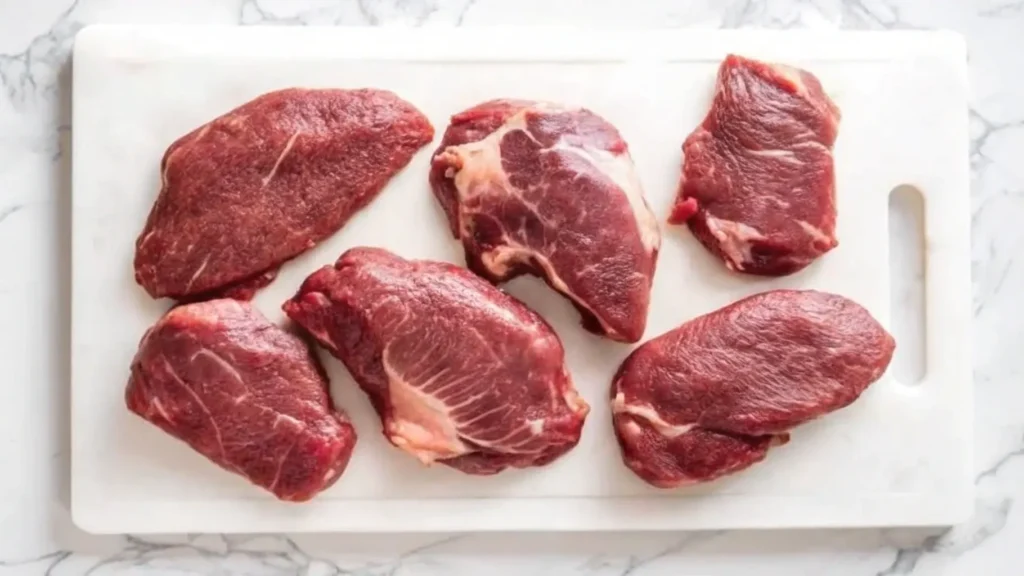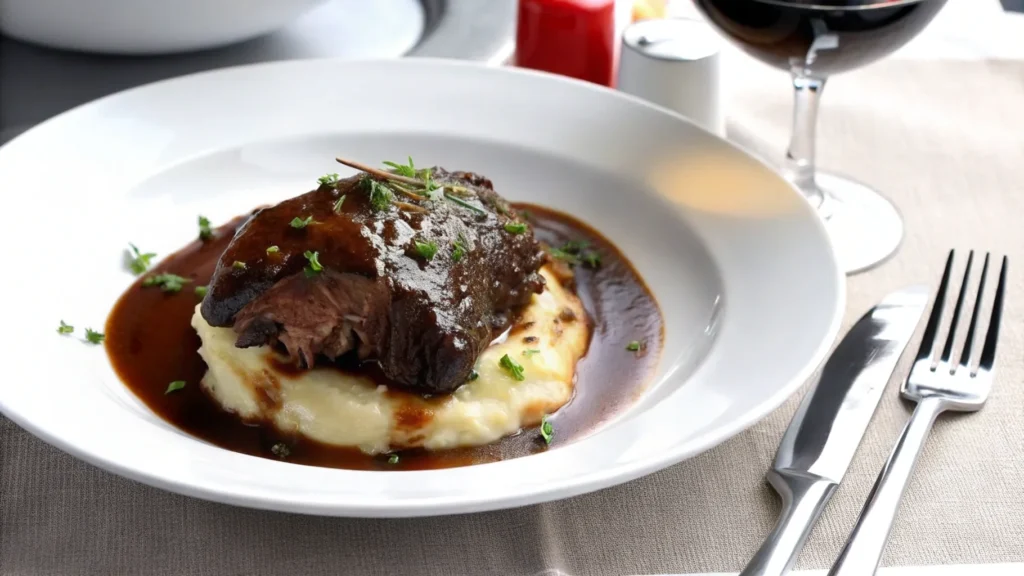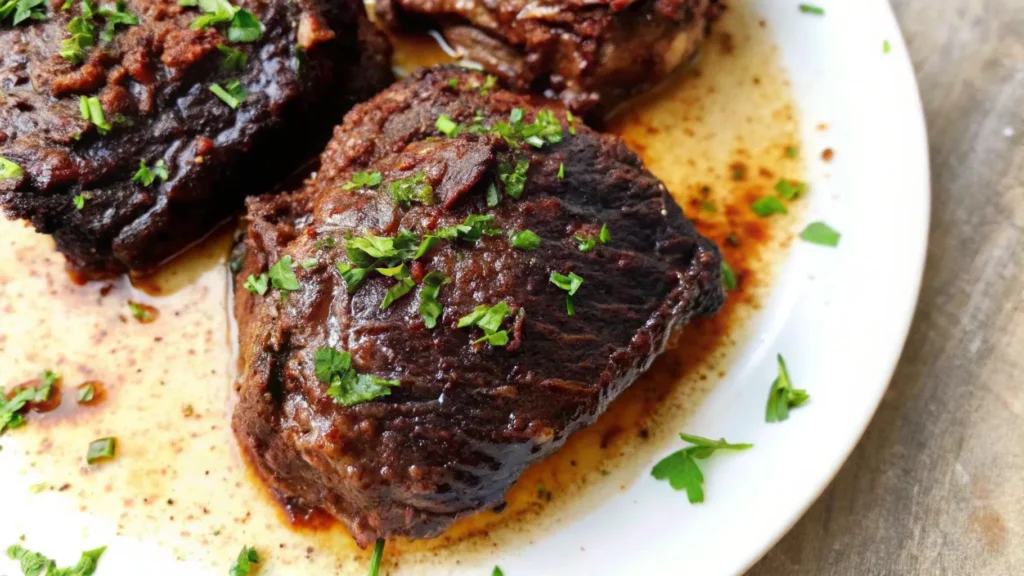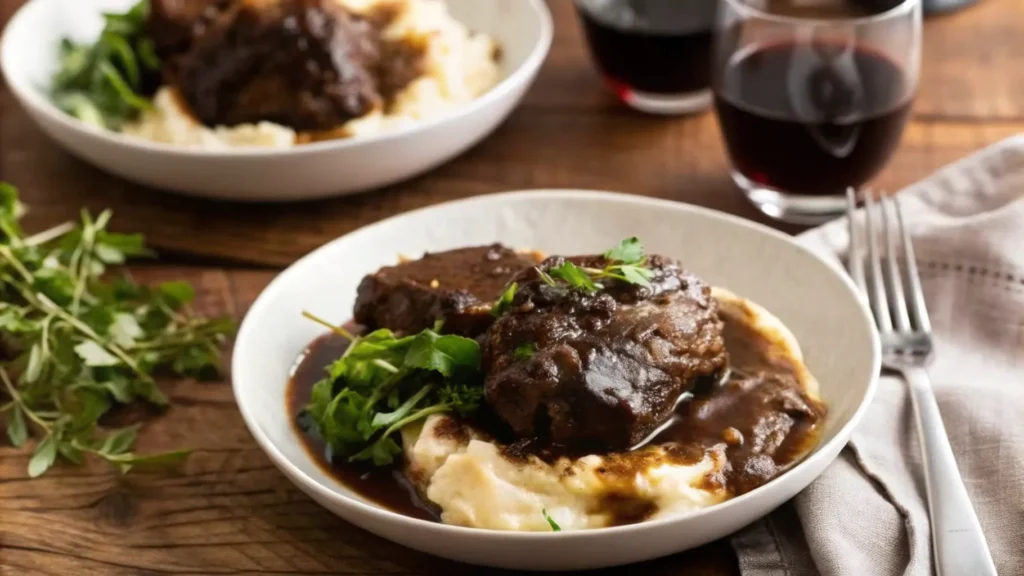
Beef cheek meat may not be the first cut you think of when you browse the butcher’s counter, but it deserves your attention. This often-overlooked cut of beef has the potential to transform into one of the most flavorful and tender dishes you’ve ever made. Once you discover the magic of beef cheeks, you’ll wonder why you haven’t been using them all along. Let’s dive into what makes this cut so extraordinary and why it should be on your cooking radar.
Table of contents
Why Beef Cheek Meat Deserves Your Attention
Beef cheek meat is a culinary treasure, prized for its tenderness and rich flavor. Unlike the more common cuts like ribeye or sirloin, beef cheeks aren’t often seen in the spotlight, but they bring a depth of flavor and a melt-in-your-mouth texture that’s truly remarkable. Whether you’re an experienced cook or a beginner, beef cheeks are a versatile and rewarding ingredient that offers something unique. Their ability to take on the flavors of the dishes they are cooked in, from savory stews to braised delicacies, makes them worthy of attention in any kitchen.
The Secret to Its Incredible Tenderness
The reason beef cheek meat is so tender lies in the muscles it’s made from. Located in the face of the cow, the cheek muscles are used a great deal, which means they’re packed with connective tissue and collagen. When cooked slowly, these tissues break down, turning the meat into a soft, juicy, and incredibly tender delight. Slow cooking methods such as braising or slow-roasting are ideal for this cut, as they allow the collagen to dissolve into a luscious, melt-in-your-mouth texture that’s unlike any other beef cut.
What Is Beef Cheek Meat?

Beef cheek meat comes from the facial muscles of the cow, and it’s known for being both flavorful and affordable. This cut is often overlooked by many, but it’s a cut that’s gaining recognition in the culinary world. Traditionally used for long cooking processes to break down its tough fibers, beef cheek meat is a true testament to the value of patience in the kitchen. Whether braised, slow-cooked, or stewed, beef cheeks deliver incredible flavor and tenderness when prepared correctly.
The Unique Cut That’s Packed with Flavor
Beef cheeks are a cut that offers far more than just tenderness; they are packed with rich, beefy flavor. The muscle’s constant use builds up a deep, hearty flavor that other cuts just can’t replicate. When cooked properly, the meat becomes succulent and juicy, taking on a buttery smoothness that is downright irresistible. Because of the collagen, the meat absorbs the flavors of spices, wine, and broth so well, creating an incredibly savory dish.
How It Differs from Other Cuts of Beef
What sets beef cheek meat apart from other cuts of beef is its unique combination of flavor and texture. While other cuts may focus more on tenderness (like filet mignon) or a deep beefy flavor (like short ribs), beef cheek meat delivers both in a perfect balance. It’s a cut that thrives when slow-cooked, transforming from a tough piece of muscle into an ultra-tender, flavorful dish. The marbling of fat throughout the meat also helps keep it juicy, unlike leaner cuts that can dry out when cooked.
Why Choose Beef Cheek Meat?

Rich, Deep Flavor That Melts in Your Mouth
Beef cheek meat is ideal for anyone looking for a deeply satisfying and flavorful cut of beef. The rich, beefy taste is unmatched, and the slow-cooking process helps the natural flavors develop and intensify. Whether you’re cooking a stew, tacos, or ragu, the depth of flavor that beef cheek meat brings to the table will leave a lasting impression.
Affordable and Budget-Friendly Cut
While premium cuts like ribeye or filet mignon can quickly drain your wallet, beef cheek meat is an affordable alternative that doesn’t sacrifice on quality. It’s a perfect choice for those who want to enjoy a delicious beef dish without breaking the bank. When prepared right, it’s just as indulgent and satisfying as pricier cuts.
Perfect for Slow Cooking and Braising
Beef cheek meat’s unique texture and rich flavor make it perfect for slow cooking methods like braising. The long, slow cooking process allows the meat to tenderize while absorbing the delicious flavors of sauces, broths, and spices. This makes it an ideal choice for hearty dishes like stews, braises, and slow-cooked roasts.
How to Buy Quality Beef Cheek Meat
What to Look for at the Butcher or Supermarket
When shopping for beef cheek meat, look for a cut that’s well-marbled with fat. This fat will melt during cooking, helping to keep the meat juicy and flavorful. Choose meat with a deep red color and firm texture. Avoid cuts that appear pale or have excessive gristle, as this could indicate that they are not fresh or properly handled.
Fresh vs. Frozen: Which Is Better?
While fresh beef cheek meat is always preferable, frozen beef cheeks can still provide excellent results when thawed and cooked properly. Fresh meat tends to have a more pronounced flavor and is easier to trim, but if you’re in a pinch, frozen beef cheeks are a great option and won’t compromise on quality if handled correctly.
Sustainable and Ethical Sourcing Options
Consider sourcing beef cheek meat from local, sustainable farms that prioritize ethical practices. Grass-fed and pasture-raised beef options are often higher in quality and more flavorful. By choosing sustainably sourced beef, you’re supporting more environmentally responsible farming methods while also ensuring a better product for your meals.
Preparing Beef Cheek Meat for Cooking
Essential Trimming Tips for the Best Texture
Before cooking beef cheek meat, it’s important to trim any excess fat or silver skin. These parts can be tough and chewy, so carefully remove them with a sharp knife. Trimming the meat properly ensures a smoother texture and makes for a more pleasant eating experience once cooked.
Should You Marinate Beef Cheek Meat?
While marinating beef cheek meat is not essential, it can enhance the flavor profile of your dish. Marinating overnight with ingredients like wine, herbs, and spices can infuse the meat with extra depth and complexity. If you don’t have time, don’t worry – slow cooking will still work wonders without a marinade.
The Best Seasonings to Enhance the Flavor
To complement the natural flavors of beef cheek meat, use herbs and spices like garlic, thyme, rosemary, and bay leaves. A splash of red wine or vinegar can help balance the richness. Keep the seasoning simple to let the meat shine, but don’t be afraid to experiment with bold flavors like smoked paprika or ancho chili powder.
Cooking Methods That Bring Out the Best in Beef Cheek Meat

Slow Cooking: The Foolproof Method for Tenderness
Slow cooking is the gold standard for preparing it. Whether you use a slow cooker, a Dutch oven, or a stovetop pot, cooking on low heat for several hours breaks down the tough fibers, resulting in tender, juicy meat. This method allows the flavors to meld together and creates an unforgettable dish.
Braising: Unlocking Deep, Rich Flavors
Braising it is a classic technique that works wonders for this cut. By browning the meat and then simmering it in a flavorful liquid (like stock, wine, or beer), it becomes incredibly tender while absorbing all the surrounding flavors. Braising is ideal for a dish that’s both comforting and sophisticated.
Pressure Cooking: A Faster Way to Perfection
If you’re short on time, pressure cooking can help you achieve the same tender results as slow cooking but in a fraction of the time. Using a pressure cooker helps retain moisture and ensures that it remains succulent and tender, with the added bonus of speeding up the cooking process.
Smoking and Grilling: Can You Do It?
While it is traditionally braised or slow-cooked, grilling and smoking can also be an option if you’re looking for a smoky, charred flavor. Smoking them can bring out unique flavors, but it requires patience. Low and slow is the key to achieving tenderness when using a grill or smoker for this cut.
Classic Beef Cheek Meat Recipes
Traditional Braised Beef Cheeks with Red Wine
A classic recipe for beef cheek meat, braised with red wine, aromatics, and fresh herbs, is a dish that epitomizes comfort and flavor. The beef becomes fork-tender as it soaks up the rich sauce, creating a luxurious meal that pairs perfectly with mashed potatoes or roasted vegetables.
Slow-Cooked Beef Cheek Tacos with a Flavorful Twist
For a fun, casual take, slow-cooked beef cheek tacos are a crowd-pleaser. The meat is shredded and packed into soft tortillas, topped with fresh garnishes like cilantro, lime, and salsa. The rich flavor of the beef pairs wonderfully with the bright, tangy toppings.
Rich and Hearty Beef Cheek Ragu for Pasta Lovers
It makes an outstanding ragu. Braised for hours in a tomato-based sauce, it becomes so tender that it falls apart into melt-in-your-mouth morsels. This ragu pairs beautifully with pasta, creating a comforting meal perfect for a family dinner.
Asian-Style Braised Beef Cheeks with Soy and Ginger
For an Asian-inspired twist, braise beef cheeks in a mixture of soy sauce, ginger, garlic, and sesame oil. This creates a tender, flavorful dish that pairs well with steamed rice or stir-fried vegetables, offering a delightful balance of savory, salty, and slightly sweet notes.
Pairing Beef Cheek Meat with the Perfect Sides
Creamy Mashed Potatoes for Ultimate Comfort
A classic pairing for beef cheek meat is creamy mashed potatoes. The smooth, buttery potatoes provide a perfect contrast to the rich, flavorful meat, making it a comforting and satisfying combination.
Rustic Bread to Soak Up All the Juices
Beef cheek dishes often produce a flavorful sauce, and there’s no better way to enjoy it than by serving it with crusty, rustic bread. The bread soaks up the sauce, ensuring you don’t miss a drop of the deliciousness.
Roasted Vegetables That Complement the Richness
Roasted root vegetables like carrots, parsnips, and potatoes bring a sweet, earthy balance to the rich, savory beef cheek meat. The caramelization from roasting adds extra flavor and texture, creating a perfect complement to the tender meat.
The Best Wines to Serve with Beef Cheek Meat
For a truly indulgent meal, pair your beef cheek dish with a bold red wine, such as a Cabernet Sauvignon, Syrah, or Malbec. The rich tannins in these wines will stand up to the deep flavors of the meat, enhancing the overall experience.
Storing and Reheating Leftover Beef Cheek Meat
The Right Way to Store for Maximum Freshness
Beef cheek meat leftovers should be stored in an airtight container in the fridge for up to three days. For longer storage, freeze the meat in portions, ensuring it’s tightly wrapped to preserve its texture and flavor.
How to Reheat Without Losing Tenderness
To reheat beef cheek meat without losing its tenderness, do so slowly. Use low heat in a covered pan or reheat in the oven covered with foil. If reheating from frozen, let it thaw overnight in the fridge before gently warming it up.
Creative Ways to Use Leftovers in New Dishes
Leftover beef cheek meat can be transformed into new meals, such as a hearty beef cheek chili, beef cheek sandwiches, or even a savory beef cheek pie. The versatility of this cut makes it perfect for creative dishes the next day.
Nutritional Benefits of Beef Cheek Meat
Packed with Protein for a Satisfying Meal
Beef cheek meat is an excellent source of protein, making it a satisfying option for those looking to fuel their body with essential nutrients. Protein is vital for muscle repair and overall health, making this cut a great addition to a balanced diet.
Rich in Collagen for Joint and Skin Health
Thanks to its collagen content, beef cheek meat is not only great for your taste buds but also beneficial for your joints and skin. Collagen is known to improve joint health and skin elasticity, adding extra wellness benefits to your meal.
Low in Fat Compared to Other Beef Cuts
While it is rich in flavor, it’s actually lower in fat compared to more marbled cuts like ribeye or brisket. This makes it a healthier option for those looking to enjoy the richness of beef without the excessive fat content.
Common Mistakes to Avoid When Cooking Beef Cheek Meat
Why Rushing the Cooking Process Leads to Tough Meat
One of the most common mistakes people make when cooking it is rushing the process. This cut requires patience; rushing can result in tough, chewy meat that doesn’t achieve its signature tenderness.
The Importance of Letting It Rest Before Serving
Resting your beef cheeks after cooking is crucial. Allowing it to sit for a few minutes lets the juices redistribute, ensuring a juicy, tender bite every time.
Over-Seasoning vs. Letting Natural Flavors Shine
It is naturally flavorful, so avoid over-seasoning it. Let the meat’s natural taste shine through with just the right amount of seasoning and herbs. Subtlety is key to bringing out the best in this cut.
Exploring Global Beef Cheek Meat Dishes
French-Inspired Beef Cheek Bourguignon
In France, it is often used in the famous dish “Boeuf Bourguignon,” where it’s braised in red wine, vegetables, and aromatics. The result is a deep, rich stew that pairs perfectly with crusty bread.
Italian-Style Osso Buco with Beef Cheeks
Osso Buco, a traditional Italian dish, is usually made with veal shanks. However, beef cheeks make a wonderful substitute, braised in white wine and broth, creating a dish that’s perfect over creamy polenta.
Mexican Barbacoa Using Beef Cheek Meat
In Mexico, barbacoa is a slow-cooked meat, often made with beef cheeks. The meat is simmered with chilies, garlic, and spices, creating a tender, flavorful filling for tacos or burritos.
Asian Slow-Braised Beef Cheek Delights
In many Asian cuisines, slow-braising beef cheeks with soy sauce, ginger, and garlic results in a dish full of umami. This method infuses the meat with complex flavors and is perfect for pairing with rice or noodles.
Final Thoughts
Why Beef Cheek Meat Should Be on Your Weekly Menu
It is a true culinary gem that should be a staple in your kitchen. Its rich flavor, tender texture, and versatility make it an ideal choice for a variety of dishes. Whether you’re cooking for a special occasion or looking for a satisfying weeknight meal, it delivers every time.
Experimenting with New Flavors and Cooking Techniques
Don’t be afraid to experiment with different flavor profiles and cooking methods. Beef cheek meat’s ability to adapt to various cuisines means the possibilities are endless. Explore global dishes and make this cut your own.
Where to Find Beef Cheek Meat for Your Next Meal
With the increasing popularity of it, it’s easier than ever to find this cut at local butcher shops, supermarkets, and even online retailers. Make sure to choose a reputable source for the best quality and flavor.
FAQs:
Is beef cheek a good cut of meat?
Yes, it’s flavorful, tender when cooked right, and great for slow cooking.
What is another name for beef cheek meat?
It’s also called “beef cheeks” or “jarret de boeuf.”
Is beef cheek meat tender?
Yes, when slow-cooked or braised, it becomes incredibly tender.
How does beef cheek taste?
It has a rich, deep flavor, more intense than other cuts, with a savory, beefy taste.
